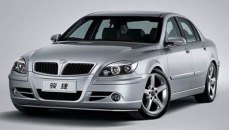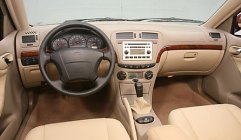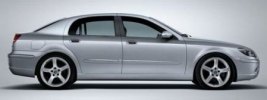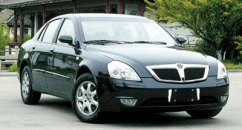|
 China
Brilliance is a mid-size car maker in China, lagging behind market
leaders SAIC (Shanghai Automotive Industrial Corporation) and FAW
(First Automotive Works) by a large margin. In 2006, it produced about
200,000 vehicles, half of which were low-quality commercial vehicles,
another half were passenger cars. Among the latter, some 22,000 units
were BMWs - BMW partnered with Brilliance to assemble 3 and 5-Series
locally in order to escape from heavy tariff - and 58,000 units were
the Zhonghua brand sedan about which we are going to talk. China
Brilliance is a mid-size car maker in China, lagging behind market
leaders SAIC (Shanghai Automotive Industrial Corporation) and FAW
(First Automotive Works) by a large margin. In 2006, it produced about
200,000 vehicles, half of which were low-quality commercial vehicles,
another half were passenger cars. Among the latter, some 22,000 units
were BMWs - BMW partnered with Brilliance to assemble 3 and 5-Series
locally in order to escape from heavy tariff - and 58,000 units were
the Zhonghua brand sedan about which we are going to talk.
Born in 2002, Zhonghua sedan, whose name means "Chinese", was the first
mass production Chinese passenger car having its own intellectual
property rights. However, that doesn't mean the Chinese developed the
car by themselves. In fact, it was designed by Giugiaro and later
facelifted by Pininfarina. It chassis was engineered by Porsche
Engineering. Its engines and transmissions are sourced from Mitsubishi.
Finally, BMW helped setting up its quality standards for production, as
the BMW lines are located under the same roof. This car was the work of
United Nation with very little input from China Brilliance itself. This
explain why AutoZine did not want to report this car in the past 4
years. However, as the car was updated and went on sale in Europe
recently, I think you might be interested to know more about it.
The European version of Zhonghua is called "BS6". It was imported by a
Luxembourg dealer which planned to sell it across Europe. Some 3,000
units already arrived Europe late last year and 15,000 units more are
planned to be sold this year. It has two weapons to lure customers –
price and size. Starting from 19,000 Euro to 23,000 Euro for a fully
loaded model, it is significantly cheaper than Ford Mondeo, Opel Vectra
and Volkswagen Passat with which it competes - and even Hyundai Sonata.
But at the same time it is considerably larger than rivals, offering a
4.9 meters length and a long wheelbase at 2.79 meters. Its use of space
is not particularly efficient, but still it offers ample room for 5
people, especially for rear passengers, and there is a
limousine-rivaling luggage space of 550 liters. Budget buyers should be
tempted. Korean car makers must be frightening…
 Unfortunately,
Chinese cars are still not in the league of Korean cars in terms of
quality. This is obvious in the cabin, where the dashboard is made of
hard plastics and parts are assembled with varying gaps. Some moving
parts look like filmsy and their durability is doubtful. The low-rent
leather seats and faux wood inserts look cheap. The driving position is
also flawed – even with the seat adjusted to the lowest position, the
driver's legs are still too close to the steering wheel. So, you might
think at least it provide long list of equipment for compensation ?
Sorry, it actually offers very little standard equipment – a simple CD
player, a poorly functioned climate control and only 2 air bags. No
traction control or ESP stability control. It doesn't sound really that
bargain compare with the richly equipped Korean cars. Unfortunately,
Chinese cars are still not in the league of Korean cars in terms of
quality. This is obvious in the cabin, where the dashboard is made of
hard plastics and parts are assembled with varying gaps. Some moving
parts look like filmsy and their durability is doubtful. The low-rent
leather seats and faux wood inserts look cheap. The driving position is
also flawed – even with the seat adjusted to the lowest position, the
driver's legs are still too close to the steering wheel. So, you might
think at least it provide long list of equipment for compensation ?
Sorry, it actually offers very little standard equipment – a simple CD
player, a poorly functioned climate control and only 2 air bags. No
traction control or ESP stability control. It doesn't sound really that
bargain compare with the richly equipped Korean cars.
Mitsubishi supplies two old engines to the car: a 2.0-liter SOHC 16V
with 122hp and a 2.4-liter SOHC 16V with 130hp. They are apparently
lack of punch. But even worse is that the large sedan weighs 1445
kilograms. Even if you opt for the 2.4 engine and manual gearbox, it
would take more than 11 seconds to accelerate from zero to sixty mph.
In addition to poor fuel consumption and vague gearshift, the
powertrain is well below the standards of class rivals. On the positive
side, at least the engines are not too noisy and wind noise is bearable
– partly helped by the low drag coefficient of 0.29.
The chassis is better than the powertrains. Zhonghua / BS6 has rather
modern suspensions, which are multi-links front and rear. The five-link
rear suspensions allow passive rear-wheel steer to eliminate oversteer
at high speed. No wonder it displays good high-speed stability on
motorways. Bump absorption is also up to job, certainly better than
Korean cars because the Chinese car is tuned to ride well on the bumpy
roads commonly found in China.
 Nevertheless, once you up the
pace and enter attack mode, it loses body control and ride compliance
quickly as a result of the soft-biased suspensions. The steering is
also too light and numb to inspire confidence. Traction could be a
problem on wet roads. If you crash, not many safety devices can save
you. It is heard that the car got only 2 stars in TUV test
simulating Europe NCAP. Nevertheless, once you up the
pace and enter attack mode, it loses body control and ride compliance
quickly as a result of the soft-biased suspensions. The steering is
also too light and numb to inspire confidence. Traction could be a
problem on wet roads. If you crash, not many safety devices can save
you. It is heard that the car got only 2 stars in TUV test
simulating Europe NCAP.
All these weaknesses are predictable for a car serving mainly as taxis
in China. In fact, very few local people buy Zhonghua as private cars.
They would rather choose the locally assembled Honda Accord, Volkswagen
Passat, Ford Mondeo, Nissan Cefiro or Mazda 6. Even though it is
claimed to be the first Chinese car designed for Chinese, it does not
appeal to the Chinese car-buying public, which is getting wiser and
wiser these days. For European market, the battle could only be more
difficult. This might be the first Chinese invasion to European car
market, but it has little chance for success.
Zhonghua, Junjie, Zunchi,
BS4
and BS6, how to distinguish?
  << Left: Zunchi (BS6); Right: Junjie
(BS4) << Left: Zunchi (BS6); Right: Junjie
(BS4)
In China, Zhonghua has two versions: Junjie (means "handsome and
agile") is the cheaper one, Zunchi (means "prestige run") is the more
upmarket version. Both cars are mechanically identical but the clothes
and trims are different. The Zunchi's exterior was facelifted by
Pininfarina and boosts longer front and rear overhangs than the cheaper
version. It also gets more luxury interior trimming and equipment to
justify the higher price.
In Europe, Junjie and Zunchi are renamed to BS4 and BS6 respectively.
|